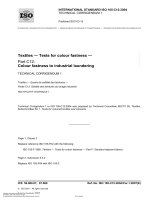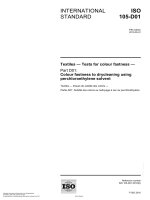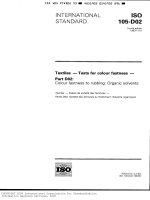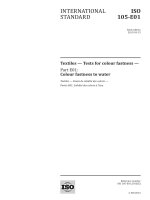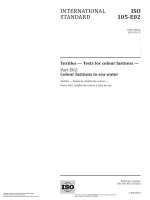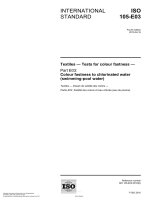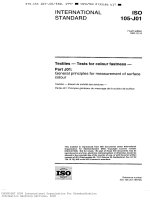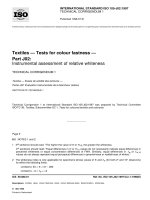Tiêu chuẩn iso 00105 g04 2016
Bạn đang xem bản rút gọn của tài liệu. Xem và tải ngay bản đầy đủ của tài liệu tại đây (326.81 KB, 14 trang )
INTERNATIONAL
STANDARD
ISO
1 05 -G04
Second edition
2 01 6-06-01
Textiles — Tests for colour fastness —
Part G04:
Colour fastness to nitrogen oxides in
the atmosphere at high humidities
Textiles — Essais de solidité des coloris —
Partie G04: Solidité des coloris aux oxydes d’azote en atmosphère à taux
d’humidité élevés
Reference number
ISO 1 05-G04: 2 01 6(E)
©
ISO 2 01 6
ISO 105-G04:2 016(E)
COPYRIGHT PROTECTED DOCUMENT
© ISO 2016, Published in Switzerland
All rights reserved. Unless otherwise speci fied, no part of this publication may be reproduced or utilized otherwise in any form
or by any means, electronic or mechanical, including photocopying, or posting on the internet or an intranet, without prior
written permission. Permission can be requested from either ISO at the address below or ISO’s member body in the country of
the requester.
ISO copyright office
Ch. de Blandonnet 8 • CP 401
CH-1214 Vernier, Geneva, Switzerland
Tel. +41 22 749 01 11
Fax +41 22 749 09 47
www.iso.org
ii
© ISO 2016 – All rights reserved
ISO 105-G04:2 016(E)
Contents
Page
Foreword ........................................................................................................................................................................................................................................ iv
Introduction .................................................................................................................................................................................................................................. v
1
Scope ................................................................................................................................................................................................................................. 1
2
Normative references ...................................................................................................................................................................................... 1
3
Principle ........................................................................................................................................................................................................................ 1
4
Apparatus and reagents ................................................................................................................................................................................ 1
5
Conditioning .............................................................................................................................................................................................................. 3
6
Test specimens ........................................................................................................................................................................................................ 3
7
Procedure ..................................................................................................................................................................................................................... 3
8
Test report................................................................................................................................................................................................................... 4
9
Notes on humidity for testing.................................................................................................................................................................. 4
Annex A (normative) Test apparatus ................................................................................................................................................................... 5
Bibliography ................................................................................................................................................................................................................................ 7
© ISO 2 01 6 – All rights reserved
iii
ISO 105-G04:2 016(E)
Foreword
ISO (the International Organization for Standardization) is a worldwide federation of national standards
bodies (ISO member bodies). The work of preparing International Standards is normally carried out
through ISO technical committees. Each member body interested in a subject for which a technical
committee has been established has the right to be represented on that committee. International
organizations, governmental and non-governmental, in liaison with ISO, also take part in the work.
ISO collaborates closely with the International Electrotechnical Commission (IEC) on all matters of
electrotechnical standardization.
The procedures used to develop this document and those intended for its further maintenance are
described in the ISO/IEC Directives, Part 1 . In particular the different approval criteria needed for the
different types of ISO documents should be noted. This document was drafted in accordance with the
editorial rules of the ISO/IEC Directives, Part 2 (see www.iso.org/directives) .
Attention is drawn to the possibility that some of the elements of this document may be the subject of
patent rights. ISO shall not be held responsible for identifying any or all such patent rights. Details of
any patent rights identi fied during the development of the document will be in the Introduction and/or
on the ISO list of patent declarations received (see www.iso.org/patents) .
Any trade name used in this document is information given for the convenience of users and does not
constitute an endorsement.
For an explanation on the meaning of ISO speci fic terms and expressions related to conformity
assessment, as well as information about ISO’s adherence to the WTO principles in the Technical
Barriers to Trade (TB T) see the following URL:
Foreword - Supplementary information .
The committee responsible for this document is ISO/TC 3 8,
coloured textiles and colorants.
Textiles,
Subcommittee SC 1,
Tests for
This second edition cancels and replaces the first edition (ISO 105-G04:1989), which has been
technically revised. The main technical changes are the following:
a) delete the test-control fabric dyed with Disperse Blue 3;
b) add the test-control fabric dyed with Disperse Violet 1 and the test-control fabric dyed with
Disperse Blue 56.
ISO 105
consists of the many parts designated by a part letter and a two-digit serial number (e.g. A01),
Textiles — Tests for colour fastness. A complete list of these is given in ISO 105 -A01.
under the general title
iv
© ISO 2 01 6 – All rights reserved
ISO 105-G04:2 016(E)
Introduction
This method is based on a test (AATCC 164-1987), developed by AATCC in response to a speci fic need
i n the U S A fo r the de te r m i n atio n o f fad i n g i n the p re s e nce o f n i tro ge n o x ide at h i gh re l ati ve hu m i d i ti e s .
S uch
c o nd i ti o n s
a re
p re va le n t
a lo n g
the
G u l f o f M e x ic o
co a s t
o f the
US A
a nd
in
S o u the r n
C a l i fo r n i a .
Fading of some dyes on certain man-made fibres, particularly on carpets, was observed to be quite
severe under such conditions. The development of this test method enabled dye manufacturers, fibre
producers and textile manufacturers to select dye/fibre combinations which were resistant to fading
in
the
p re s e nc e
o f n i tro ge n
o x i de
at
h i gh
re l ati ve
hu m id i ti e s .
T he
s a me
fab r ic s ,
whe n
te s te d
at
lo w
hu m id i tie s , s ho we d l i t tle o r no fad i n g.
© I S O 2 0 1 6 – Al l ri gh ts re s e rve d
v
INTERNATIONAL STANDARD
ISO 105-G04:2 016(E)
Textiles — Tests for colour fastness —
Part G 0 4 :
Colour fastness to nitrogen oxides in the atmosphere at
high humidities
1
Scope
This part of ISO 105 speci fies a method for determining the resistance of the colour of textiles to the
ac ti o n o f n i tro ge n o x ide i n the atmo s p he re at e le vate d te mp e ratu re s a nd h i gh re l ati ve hu m id i tie s .
Fo r te s ti n g at lo we r hu m id i ti e s , s e e I S O 1 0 5 - G 0 1 .
2
Normative references
The following documents, in whole or in part, are normatively referenced in this document and are
indispensable for its application. For dated references, only the edition cited applies. For undated
references, the latest edition of the referenced document (including any amendments) applies.
Textiles — Tests for colour fastness — Part A02: Grey scale for assessing change in colour
I S O 1 0 5 - A0 2 ,
I S O 10 5 - C10 ,
and soda
Textiles — Tests for colour fastness — Part C10: Colour fastness to washing with soap or soap
Textiles — Tests for colour fastness — Part D01: Colour fastness to drycleaning using
perchloroethylene solvent
ISO
10 5 -D 01 ,
I S O 1 3 9,
3
Textiles — Standard atmospheres for conditioning and testing
Principle
A test specimen and a piece of test-control fabric are simultaneously exposed to nitrogen oxide in an
atmosphere which is maintained at 87,5 % ± 2,5 % relative humidity and a temperature of 40 °C ± 1 °C
u nti l the te s t- co n tro l fab r i c s ho ws a c o lo u r ch a n ge - c o r re s p o nd i n g to th at o f a s t a n d a rd o f fad i n g.
The exposure/measurement cycle is repeated until the test specimen shows a de finite colour change or
for a prescribed number of cycles.
4
Apparatus and reagents
4.1
Exposure chamber,
4.2
Test-control fabric
4.2 .1
s e e An n ex A.
Test-control fabric dyed with Disperse Violet 1
A woven filament acetate is uniformly dyed in an open-width dyeing machine with 0,4 % (on mass of
fabric) Cl Disperse Violet 1 (Colour Index, Third Edition) in a dye-bath containing 1 g/l of a dispersing
a ge n t at a l i quo r ratio o f 1 0 : 1 .
© I S O 2 0 1 6 – Al l ri gh ts re s e rve d
1
ISO 105-G04:2016(E)
The fabric construction has both a taffeta and a satin side; for this test procedure, only the taffeta side
will be considered.
The resistance of the test-control fabric to the action of nitrogen oxides should not be varied between
the new lots. The supplier should con firm the performance of the new lot. 1)
4.2.2 Test-control fabric dyed with Disperse Blue 56
A woven filament acetate is uniformly dyed in an open-width dyeing machine with 0,8 % (on mass of
fabric) CI Disperse Blue 56 (Colour Index, Third Edition) in a dye-bath containing 0,5 ml/l of a dispersing
agent at a liquor ratio of 42:1 .
The fabric construction has both a taffeta and a satin side; for this test procedure, only the taffeta side
will be considered.
The resistance of the test-control fabric to the action of nitrogen oxide should not be varied between
the new lots. The supplier should con firm the performance of the new lot. 2)
4.3 Standard of fading
4.3.1 Standard fading fabric for test-control fabric dyed with Disperse Violet 1
The regenerated cellulose woven taffeta is a fabric of similar appearance to the test-control fabric (4. 2 .1) ,
dyed to match an average of faded test-control fabric. 3 )
4.3.2 Standard of fading for test-control fabric dyed with Disperse Blue 56
It is considered that the standard of fading is completed when a faded test-control fabric (4. 2 . 2) is
observed to have a contrast equal to grade 3-4 on the in grey scale.
4.4 Grey scale for assessing change in colour, complying with ISO 105-A02.
4.5 Nitrogen oxide
Use bottled gas which contains approximately 1 % nitrogen dioxide in nitrogen, in cylinders equipped
with the proper reducing valves. For safety, chain the cylinders to a wall so that they cannot fall or be
knocked down.
WARNING — Nitrogen oxide in high concentrations are injurious to health and should be
exhausted to the atmosphere or trapped in water and neutralized with a 10 % (m/m) solution of
sodium hydroxide or sodium 3hydrogen carbonate. The maximum concentration in a work area
should not exceed 9,57 mg/m .
4.6 Urea after treatment
The use of this treatment is optional.
E xperience has shown that colour change after removal of test specimens from the exposure chamber
is negligible. The urea treatment itself will often cause a colour change in test specimens. Therefore, if
Test-control fabric dyed with Disperse Violet 1 is commercially available from Testfabrics, Inc. This information
is given for the convenience of users of this document and does not constitute an endorsement by ISO this product.
2)
Test-control fabric dyed with Disperse Blue 56 is commercially available from the Japanese Standards
1)
Association.. This information is given for the convenience of users of this document and does not constitute an
endorsement by ISO this product.
3)
The standard fading fabric is commercially available from Testfabrics, Inc. This information is given for the
convenience of users of this document and does not constitute an endorsement by ISO this product.
2
© ISO 2 01 6 – All rights reserved
ISO 105-G04:2 016(E)
this procedure is used, it is essential that both the exposed and unexposed test-control fabric be treated
in an identical manner.
), buffered to pH 7 by the addition of 0,4 g/l
of sodium dihydrogen orthophosphate dehydrate (NaH 2 PO 4 ·2 H 2 O), and 2,5 g/l of disodium hydrogen
orthophosphate dodecahydrate (Na2 HPO 4 ·12 H 2 O) , and containing 0,1 g/l or less of a rapid-wetting
surface-active agent; for example, sodium dioctyl sulfosuccinate.
Use urea solution containing 10 g/l of urea (NH 2 CONH 2
5
Conditioning
The standard temperate atmosphere for testing textiles (see ISO 139), i.e. a relative humidity of
(65 ± 4) % and temperature of (20 ± 2) °C, shall be used for conditioning.
6
Test specimens
Cut out test specimens measuring at least 60 mm × 60 mm. For subsequent colour comparison, the
unexposed sample shall be kept in an airtight container away from light to avoid further colour changes
If the test involves the effect of nitrogen oxide on laundered or dry-cleaned material, use laundered
or dry-cleaned material for both the control and test exposure. For the preparation of test specimens
for testing after laundering or dry cleaning, follow the procedures described in ISO 105-C10 and/or
ISO 105-D01. While laundering or dry-cleaning before testing, the size of the test specimens also meets
at least 60 mm × 60 mm.
7
7.1
(4.1
Procedure
Suspend the test specimens and piece of test-control fabric (4.2 .1 or 4.2 .2 ) in the exposure chamber
) which should produce a cycle of fade within 5 h to 15 h of exposure.
Examine the test-control fabric periodically until its colour corresponds to that of the standard of
fading. This constitutes one cycle. An alternative method of determining one cycle of fade is to terminate
the exposure cycle when the test-control fabric exhibits a colour change of (16,5 ± 1,5) CIELAB units (see
ISO 105-J01).
7.2
Remove those test specimens which exhibit a noticeable colour change at the end of one cycle. One
cycle will generally produce a measurable colour change in samples which are sensitive to nitrogen oxide.
7.3
7.4
Suspend a fresh piece of test-control fabric (4.2 .1 or 4.2 .2
required number of cycles has been completed.
) for each additional cycle of fade until the
Test specimens exposed to nitrogen oxide may continue to change colour after removal from the test
chamber. The colour may be stabilized by plunging them into a buffered urea solution (see 4.6) for 5 min,
squeezing them out, thoroughly rinsing them in clean water and drying them in air at a temperature
not above 60 °C. Do not treat with the urea solution any test specimen that is to be returned to the test
chamber for additional exposure.
At the end of each cycle, immediately assess the change in colour of the test specimen using the
grey scale for assessing change in colour (4.4) .
7.5
7.6
Classify the effect on colour of test specimens after the speci fied number of cycles, using the grey
scale for assessing change in colour (4.4) .
© ISO 2 01 6 – All rights reserved
3
ISO 105-G04:2 016(E)
8
Test report
T he te s t re p o r t s h a l l i nc l ude the fo l l o w i n g:
a) the date of test;
b) the number and year of publication of this part of ISO 105, i.e. ISO 105-G04:2016;
c) all details necessary for the identi fication of the test specimen tested;
d) the type of the test-control fabric used;
e) the numerical rating for the change in colour of each test specimen using the grey scale;
f)
the number of cycles of exposure;
g) the temperature and relative humidity at which the test was performed.
9
Notes on humidity for testing
The fading of dyes by nitrogen oxide on some fibres, such as polyamide and acetate, is altered greatly by
relatively small variations in relative humidity at high humidities. Therefore, to achieve reproducibility
and good interlaboratory correlation in test results, close control of temperature and relative humidity
i s re qu i re d .
4
© I S O 2 0 1 6 – Al l ri gh ts re s e rve d
ISO 105-G04:2 016(E)
Annex A
(normative)
Test apparatus
Suitable test apparatus is shown in Figure A.1
holes on the top and a thermostatic water bath.
and consists of a 15 l capacity bell-jar having five plug-
The exposure chamber is made of stainless steel which is coated on the inside with a resistant coating,
capable of maintaining an atmosphere having a relative humidity of (87,5 ± 2,5) % at a temperature
(40 ± 1) °C and containing nitrogen dioxide at a concentration by volume of 8,96 mg/m 3 .
Inside the bell-jar are placed a glass cylinder, 165 mm ± 2 mm in diameter and 225 mm ± 1 mm in
height, standing on three supports made of inert material (for example, silicone rubber or glass) , a
temperature and humidity sensor, two evaporating dishes and a stainless-steel frame for suspending
the test specimens.
Through one of the top plug-holes passes a spindle bearing a stainless-steel or plastics fan,
145 mm ± 5 mm in diameter, adjusted so that its lower edge is approximately 20 mm from the upper
rim inside the glass cylinder.
A stainless-steel rod is let through the other top plug-hole and holds the test-control fabric. This holder
is located between the glass cylinder and the bell-jar.
And also inside the bell-jar are placed two evaporating dishes and a temperature and humidity sensor.
Any other apparatus yielding the same results can also be used.
Care shall be taken to carry out the test under identical conditions, i.e. the ratio between number of test
specimens, space in the test chamber and amount of gas shall always be the same.
© ISO 2 01 6 – All rights reserved
5
ISO 105-G04:2 016(E)
Key
1
stainless steel rod
8
test specimen
2
temperature and humidity sensor
9
supports
3
gas inlet
10
evaporating dishes (for pure water)
4
fan
11
bell-jar
5
thermostatic water bath
12
glass cylinder
6
stainless-steel frame
13
pure water inlet
7
test-control fabric
14
motor
Figure A.1 — Exposure chamber
6
© ISO 2 01 6 – All rights reserved
ISO 105-G04:2 016(E)
Bibliography
[1]
[2 ]
[3 ]
I S O 10 5 - G01 ,
Textiles — Tests for colour fastness — Part G01: Colour fastness to nitrogen oxide
I SO 10 5 -J01 , Textiles — Tests for colour fastness — Part J01: General principles for measurement of
surface colour
C o lo u r I n de x Re v i s e d T h i rd E d i tio n
© I S O 2 0 1 6 – Al l ri gh ts re s e rve d
7
ISO 105-G04:2 016(E)
ICS 59.080.01
Price based on 7 pages
© ISO 2016 – All rights reserved
